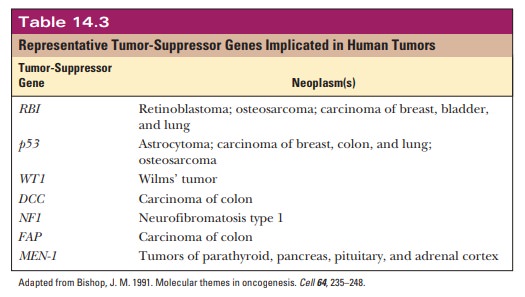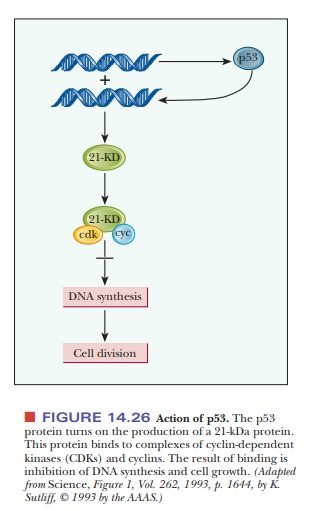Chapter: Biochemistry: Viruses, Cancer, and Immunology
Tumor Suppressors
Tumor Suppressors
Many human genes produce proteins called tumor suppressors. Tumor suppressors inhibit transcription of genes
that would cause increased replication. When a mutation occurs in any of these
suppressors, replication and division become uncontrolled and tumors result.
Table 14.3 lists some human tumor-suppressor genes.

A 53-kDa protein designated p53
has become the focus of feverish activ-ity in cancer research. Mutations in the
gene that codes for p53 are found in more than half of all human cancers. When
the gene is operating normally, it acts as a tumor suppressor; when it is
mutated, it is involved in a wide variety of cancers. By the end of 1993,
mutations in the p53 gene had been
found in 51 types of human tumors. The role of p53 is to slow down cell
division and to promote cell death (apoptosis) under certain circumstances,
including when DNA is damaged or when cells are infected by viruses.
It is known that p53 binds to the basal transcription machinery
(one of the TAFs bound to TFIID;). When cancer-causing mutations occur in p53,
it can no longer bind to DNA in a normal fashion. The mode of action of p53 as
a tumor suppressor is twofold. As shown in Figure 14.26, it is an acti-vator of
RNA transcription; it “turns on” the transcription and translation of several
genes. One of them, Pic1, encodes a
21-kDa protein, P21, that is a key
regulator of DNA synthesis and thus of cell division. The P21 protein, which is
present in normal cells but is missing from (or mutated in) cancer cells, binds
to the enzymes known as cyclin-dependent
protein kinases (CDKs), which, as their name implies, become active only
when they associate with proteins called cyclins. Recall that cell division
depends on the activity of cyclin-dependent kinases. Some of the oncogenes seen
above work in such a way that the result is an overproduction of the CDK
proteins, which keeps the cells dividing continuously. Normal levels of p53
protein cannot turn these genes off in cancer cells, but they could do this in
normal cells. In normal cells, the result is that the cell cycle remains in the
state between mitosis (in which cells divide) and the replication of DNA for
the next cell division. DNA repair can take place at this stage. If the
attempts at DNA repair fail, the p53 protein may trigger apoptosis, the
programmed cell death characteristic of normal cells, but not of cancer cells.

The important point is that two different mechanisms are operating here. One is analogous to the brakes failing in your car (inadequate or defective p53 protein) and the other (overproduction of CDKs) is equivalent to the accelerator sticking in the open position—two opposite mechanisms with the same result: the car crashes.
A number of factors come together in explaining the variety of
diseases we call cancer. Mutations of DNA lead to changes in the proteins that
control cell growth, by either directly causing cell division or allowing it to
occur by default. Still other mutations interfere with DNA repair. The
possibility of finding new cancer therapies—and perhaps even cancer cures—is
enhanced by under-standing these contributing factors and how they affect each
other.
Related Topics